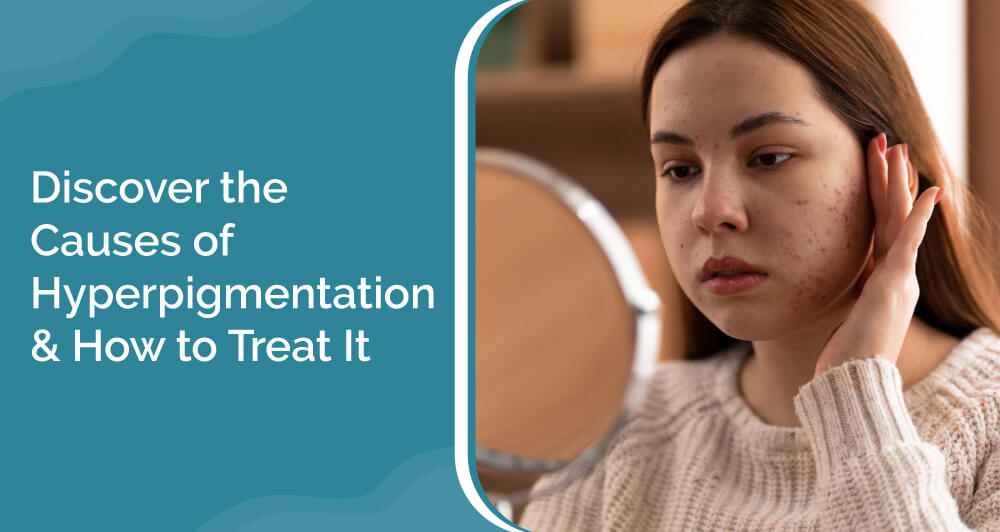November 9, 2024
Have you ever noticed dark spots or uneven skin tone that refuses to fade away? That’s hyperpigmentation—a condition many of us face, yet few understand fully. Hyperpigmentation happens when your body makes more melanin than usual, creating dark spots. It can occur for various reasons, including sun exposure, acne scars, or hormonal changes. However, understanding the causes of hyperpigmentation can help you take control. Whether you’re dealing with melasma or age spots, the proper treatment can make all the difference.
In this blog, we will discuss different causes of hyperpigmentation and how to treat them to regain smooth, evenly toned skin. Let’s get started!
A] What Is Hyperpigmentation And Its Types
Hyperpigmentation on the skin refers to darker spots on the body compared to the natural colour. These patches of discolouration can develop anywhere on the skin but are most often seen on sun-exposed areas such as the face, neck, chest, arms, hands, and shins. Based on your skin complexion, these areas can appear brown, tan, pink, grey, black or even purple. As opposed to a suntan, which is temporary, hyperpigmentation tends to be more long-lasting, although areas may lighten or fade with time and treatment.
Hyperpigmentation occurs when skin cells produce too much melanin, the protein pigment that colours our skin and hair. Some of the common types of hyperpigmentation on the face include:
- Melasma: Melasma hyperpigmentation is also known as chloasma or the mask of pregnancy when it occurs in pregnant women. It is a skin condition that causes brown or grey-brown patches or freckle-like spots on the skin. Melasma affects females more often than males and occurs mostly on the stomach and face.
- Sunspots: Also known as liver spots of solar lentigines, sunspots are common types of hyperpigmentation. They generally appear in areas exposed to the sun, such as hands and face.
- Post-Inflammatory Hyperpigmentation: This results from an injury or inflammation of the skin. Its common cause is acne.
If you are looking for skin pigmentation treatment in Mumbai to help you achieve an even skin tone, contact us!
Take control of your skin! Understand the root causes of hyperpigmentation.
B] Common Causes of Hyperpigmentation
1. Sun Exposure
Sun exposure is one of the leading causes of hyperpigmentation. Ultraviolet rays stimulate melanin production, the pigment responsible for skin colour. Overexposure causes the melanin to cluster together, creating dark patches. This prolonged sun exposure usually leads to hyperpigmentation that includes melasma, sunspots, and freckles.
2. Acne Inflammation, Cuts, or Skin Conditions
Post-inflammatory hyperpigmentation is the dark marks formed due to inflammation from acne, cuts, and other skin conditions such as eczema. Excess melanin production during healing causes these scars to appear well after the injury or pimple has healed.
3. Hormonal Changes
Hormonal changes are an easily identifiable cause of melasma hyperpigmentation, most of which occur in women. Melasma often results from changes within a female’s body due to pregnancy and the intake of oral contraceptives or hormone therapies, which can cause irregular patches of the skin to darken and become intensely dark brown or grey.
4. Medications
While some medications, such as antibiotics or chemotherapy drugs, can cause skin hyperpigmentation, the pigmentation fades away with time.
5. Skin Ageing and Genetics
Ageing and genetics are the most common causes of pigmentation disorders. Melanin spreads unevenly with age, resulting in dark spots or different forms of hyperpigmentation, commonly known as age spots. Hyperpigmentation can also be inherited.
6. Stress and Lifestyle Contributors
Chronic stress, smoking, and sleep deprivation are some factors that can cause hormonal imbalance, which may worsen the possibility of hyperpigmentation on the skin. Lifestyle changes can be of great help in preventing hyperpigmentation.
If you are looking for a dermatologist in Mumbai who can help you treat hyperpigmentation, Auro Skin Clinic is here to help! Our experts help you have healthy and even skin-toned skin.
C] Treatment Options for Hyperpigmentation
Clinical treatments for hyperpigmentation are helpful as they are effective, especially with stubborn patches on the skin that are caused by melasma, sun damage, or acne scars. The following are some of the most popular treatment options:
1. Chemical Peels
Chemical peels are more effective for treating hyperpigmentation. A chemical peel is a process in which acids such as glycolic or salicylic acid are applied to peel off the dead cells from the skin. This would lead to an even toned skin. This method is helpful in managing melasma pigmentation and post-inflammatory hyperpigmentation (PIH).
2. Laser Therapy
Laser therapy is gaining popularity for its precision in targeting pigment cells. Laser breaks down the excess melanin, helping it treat age spots and melasma. If you are looking for laser treatment in Mumbai, contact Auro Skin Clinic.
3. Microdermabrasion
Microdermabrasion is a mild exfoliation procedure that stimulates skin cells to minimise discolouration. It is ideal for conditions of mild severity, such as photoaging or chronological ageing.
4. Microneedling
Microneedling causes micro-wounds in the skin to provoke collagen formation and improve texture. It is especially good at managing post-inflammatory hyperpigmentation caused by acne. When combined with a tailored skincare regimen recommended by a skin specialist in Mumbai, the results can be more impressive and quicker.
5. Intense Pulsed Light (IPL) Treatment
IPL therapy employs light pulses to penetrate deeply located pigmentation in the skin. It is a multifunctional treatment for several types of pigmentation, such as freckles and sunspots. It can also be effective for melasma and needs to be paired with multiple other treatments.
6. Cryotherapy
Cryotherapy freezes pigmented regions, killing the darkened cells that will flake away. It is an effective and relatively fast treatment used for a small, painful spot of skin condition, like freckles or age spots.
7. Topical Medications
In addition to clinical procedures, dermatologists often prescribe topical treatments like hydroquinone, retinoids, or azelaic acid to help lighten the pigmentation. Consult a dermatologist for personalised care and ensure you have the right approach for your skin.
D] How Long Does Treatment Take?
The time to treat hyperpigmentation depends on the type of pigmentation. Mild hyperpigmentation can fade in 3-6 months with consistent treatment. Moderate hyperpigmentation can fade in 6 to 12 months, and severe pigmentation can take a year or more. However, remember that the effectiveness of the treatment depends on how the boy reacts.
E] Prevention Tips of Hyperpigmentation
Once the dermatologist can diagnose the cause of hyperpigmentation, they will request your medical history and give a physical exam to create a treatment plan. However, it is not always possible to prevent hyperpigmentation. But there are some ways how you can prevent hyperpigmentation:
- Use sunscreen with a broad spectrum of SPF 30 or higher to protect you from UV rays.
- Avoid picking your skin if you have pimples in order to avoid leaving acne marks or scars.
- You should maintain a gentle skincare routine without multiple active agents to avoid skin irritation.
Take control of your skin! Understand the root causes of hyperpigmentation.
Conclusion
Hyperpigmentation can be challenging, but with the right knowledge and treatment approach, you can achieve healthier and even-toned skin. Whether you are dealing with melasma and hyperpigmentation, sunspots, or acne scars, at Auro Skin Clinic, we provide personalised care to help you overcome hyperpigmentation on your skin. Our experts offer a range of solutions and customised skin care plans to help restore healthy skin. Do not let dark spots hold you back; contact us and take the first step towards healthy skin today!

